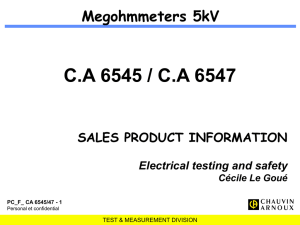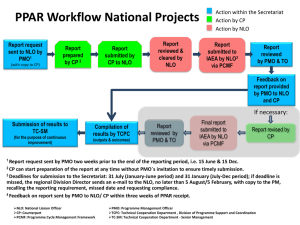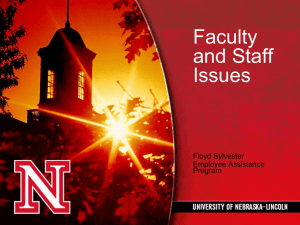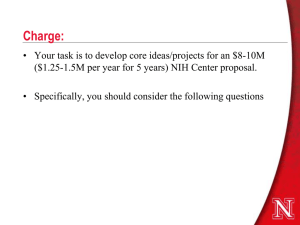Document
advertisement
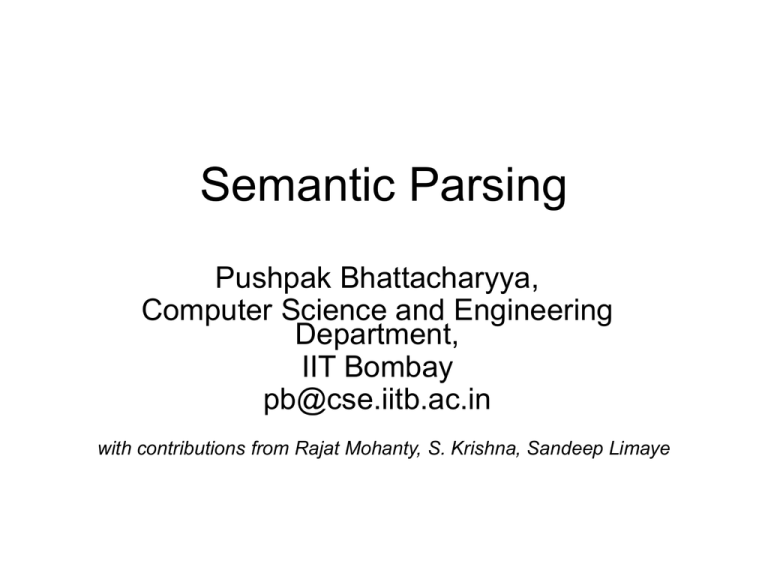
Semantic Parsing
Pushpak Bhattacharyya,
Computer Science and Engineering
Department,
IIT Bombay
pb@cse.iitb.ac.in
with contributions from Rajat Mohanty, S. Krishna, Sandeep Limaye
Motivation
• Semantics Extraction has many applications
– MT
– IR
– IE
• Does not come free
• Resource intensive
– Properties of words
– Conditions of relation establishment between words
– Disambiguation at many levels
• Current Computational Parsing less than
satisfactory for deep semantic analysis
Roadmap
• Current important parsers
– Experimental observations
– Handling of difficult language phenomena
• Brief Introduction to the adopted Semantic
Representation:
– Universal Networking Language (UNL)
• Two stage process to UNL generation:
approach-1
• Use of better parser: approach-2
• Consolidating statement of resources
• Observations on treatment of verb
• Conclusions and future work
Current parsers
Categorization of parsers
Output
Constituency
Dependency
Earley Chart
(1970), CYK
(1965-70), LFG
(1970), HPSG
(1985)
Charniack
(2000), Collins
(1999),
Stanford
Link (1991),
Minipar (1993)
Method
Rule Based
Probabilistic
Stanford
(2006), MST
(2005), MALT
(2007)
Observations on some wellknown Probabilistic Constituency
Parsers
Parsers investigated
• Charniak: Probabilistic Lexicalized Bottom-Up
Chart Parser
• Collins: Head-driven statistical Beam Search
Parser
• Stanford: Probabilistic A* Parser
• RASP: Probabilistic GLR Parser
Investigations based on
•
•
•
•
•
•
Robustness to Ungrammaticality
Ranking in case of multiple parses
Handling of embeddings
Handling of multiple POS
Words repeated with multiple POS
Complexity
Handling ungrammatical
sentences
Charniak
• has
labelled
as aux
S
NP
VP
NNP
AUX
VP
Joe
has
VBG
NP
reading
DT
NN
the
book
Joe has reading the book
Collins
• has
should
have
been
AUX
Stanford
• has is treated as
VBZ and not AUX.
RASP
• Confuses as a
case of sentence
embedding
Ranking in case of multiple
parses
Charniak
S
NP
VP
SBAR
NNP
VBD
S
John
said
NP
VP
VB
VBD
NP
PP
Marry
sang
DT
NN
IN
NP
the
song
with
NNP
MaX
John said Marry sang the song with Max
• semantically
correct one
chosen from
among
possible
multiple
parse trees
Collins
Wrong
attachment
Stanford
Same as
Charniak
RASP
• Different
POS Tags,
but parse
trees are
comparable
Time complexity
Time taken
• 54 instances of the sentence ‘This is just to
check the time’ is used to check the time
• Time taken
–
–
–
–
Collins : 40s
Stanford : 14s
Charniak : 8s
RASP : 5s
• Reported complexity
–
–
–
–
Charniack: O(n5)
Collins: O(n5)
Stanford: O(n3)
RASP: not known
Embedding Handling
Charniak
A
S
NP
NP
SBAR
VP
DT
NN
WHNP
S
The
cat
WDT
VP
that
VBD
PP
spilled
IN
NP
SBAR
on
DT
NN
IN
S
the
floor
that
VP
VBD
escaped
VBD
NP
killed
NP
SBAR
DT
NN
WHNP
S
the
rat
WDT
VP
that
VBD
NP
stole
NP
SBAR
DT
NN
WHNP
that
WDT
The cat that killed the rat that stole the milk that spilled on the
floor that was slippery escaped.
S
VP
A
AUX
ADJP
was
slippery
Collins
Stanford
RASP
Handling words with multiple
POS tags
Charniack
S
Time flies like an arrow
NP
VP
NNP
VBZ
PP
Time
flies
IN
NP
like
DT
NN
an
arrow
Collins
Stanford
RASP
• Flies tagged as
noun!
Repeated Word handling
Charniak
S
NP
VP
NNP
VBZ
Buffalo buffaloes
Buffalo buffaloes Buffalo buffaloes buffalo
buffalo Buffalo buffaloes
SBAR
S
NP
VP
NNP
VBZ
SBAR
Buffalo
buffaloes
S
NP
VP
NN
NNP
buffalo
buffalo
NNP
VBZ
Buffalo buffaloes
Collins
Stanford
RASP
• Tags all words as nouns!
Sentence Length
Sentence with 394 words
•
One day, Sam left his small, yellow home to head towards the meat-packing plant where he worked, a task which
was never completed, as on his way, he tripped, fell, and went careening off of a cliff, landing on and destroying
Max, who, incidentally, was also heading to his job at the meat-packing plant, though not the same plant at which
Sam worked, which he would be heading to, if he had been aware that that the plant he was currently heading
towards had been destroyed just this morning by a mysterious figure clad in black, who hailed from the small,
remote country of France, and who took every opportunity he could to destroy small meat-packing plants, due to
the fact that as a child, he was tormented, and frightened, and beaten savagely by a family of meat-packing plants
who lived next door, and scarred his little mind to the point where he became a twisted and sadistic creature,
capable of anything, but specifically capable of destroying meat-packing plants, which he did, and did quite often,
much to the chagrin of the people who worked there, such as Max, who was not feeling quite so much chagrin as
most others would feel at this point, because he was dead as a result of an individual named Sam, who worked at
a competing meat-packing plant, which was no longer a competing plant, because the plant that it would be
competing against was, as has already been mentioned, destroyed in, as has not quite yet been mentioned, a
massive, mushroom cloud of an explosion, resulting from a heretofore unmentioned horse manure bomb
manufactured from manure harvested from the farm of one farmer J. P. Harvenkirk, and more specifically
harvested from a large, ungainly, incontinent horse named Seabiscuit, who really wasn't named Seabiscuit, but
was actually named Harold, and it completely baffled him why anyone, particularly the author of a very long
sentence, would call him Seabiscuit; actually, it didn't baffle him, as he was just a stupid, manure-making horse,
who was incapable of cognitive thought for a variety of reasons, one of which was that he was a horse, and the
other of which was that he was just knocked unconscious by a flying chunk of a meat-packing plant, which had
been blown to pieces just a few moments ago by a shifty character from France.
Partial RASP Parse
•
(|One_MC1| |day_NNT1| |,_,| |Sam_NP1| |leave+ed_VVD| |his_APP$| |small_JJ| |,_,| |yellow_JJ| |home_NN1| |to_TO| |head_VV0| |towards_II| |the_AT| |meatpacking_JJ| |plant_NN1| |where_RRQ| |he_PPHS1| |work+ed_VVD| |,_,| |a_AT1| |task_NN1| |which_DDQ| |be+ed_VBDZ| |never_RR| |complete+ed_VVN| |,_,| |as_CSA|
|on_II| |his_APP$| |way_NN1| |,_,| |he_PPHS1| |trip+ed_VVD| |,_,| |fall+ed_VVD| |,_,| |and_CC| |go+ed_VVD| |careen+ing_VVG| |off_RP| |of_IO| |a_AT1| |cliff_NN1| |,_,|
|land+ing_VVG| |on_RP| |and_CC| |destroy+ing_VVG| |Max_NP1| |,_,| |who_PNQS| |,_,| |incidentally_RR| |,_,| |be+ed_VBDZ| |also_RR| |head+ing_VVG| |to_II|
|his_APP$| |job_NN1| |at_II| |the_AT| |meat-packing_JB| |plant_NN1| |,_,| |though_CS| |not+_XX| |the_AT| |same_DA| |plant_NN1| |at_II| |which_DDQ| |Sam_NP1|
|work+ed_VVD| |,_,| |which_DDQ| |he_PPHS1| |would_VM| |be_VB0| |head+ing_VVG| |to_II| |,_,| |if_CS| |he_PPHS1| |have+ed_VHD| |be+en_VBN| |aware_JJ|
|that_CST| |that_CST| |the_AT| |plant_NN1| |he_PPHS1| |be+ed_VBDZ| |currently_RR| |head+ing_VVG| |towards_II| |have+ed_VHD| |be+en_VBN| |destroy+ed_VVN|
|just_RR| |this_DD1| |morning_NNT1| |by_II| |a_AT1| |mysterious_JJ| |figure_NN1| |clothe+ed_VVN| |in_II| |black_JJ| |,_,| |who_PNQS| |hail+ed_VVD| |from_II| |the_AT|
|small_JJ| |,_,| |remote_JJ| |country_NN1| |of_IO| |France_NP1| |,_,| |and_CC| |who_PNQS| |take+ed_VVD| |every_AT1| |opportunity_NN1| |he_PPHS1| |could_VM|
|to_TO| |destroy_VV0| |small_JJ| |meat-packing_NN1| |plant+s_NN2| |,_,| |due_JJ| |to_II| |the_AT| |fact_NN1| |that_CST| |as_CSA| |a_AT1| |child_NN1| |,_,| |he_PPHS1|
|be+ed_VBDZ| |torment+ed_VVN| |,_,| |and_CC| |frighten+ed_VVD| |,_,| |and_CC| |beat+en_VVN| |savagely_RR| |by_II| |a_AT1| |family_NN1| |of_IO| |meat-packing_JJ|
|plant+s_NN2| |who_PNQS| |live+ed_VVD| |next_MD| |door_NN1| |,_,| |and_CC| |scar+ed_VVD| |his_APP$| |little_DD1| |mind_NN1| |to_II| |the_AT| |point_NNL1|
|where_RRQ| |he_PPHS1| |become+ed_VVD| |a_AT1| |twist+ed_VVN| |and_CC| |sadistic_JJ| |creature_NN1| |,_,| |capable_JJ| |of_IO| |anything_PN1| |,_,| |but_CCB|
|specifically_RR| |capable_JJ| |of_IO| |destroy+ing_VVG| |meat-packing_JJ| |plant+s_NN2| |,_,| |which_DDQ| |he_PPHS1| |do+ed_VDD| |,_,| |and_CC| |do+ed_VDD|
|quite_RG| |often_RR| |,_,| |much_DA1| |to_II| |the_AT| |chagrin_NN1| |of_IO| |the_AT| |people_NN| |who_PNQS| |work+ed_VVD| |there_RL| |,_,| |such_DA| |as_CSA|
|Max_NP1| |,_,| |who_PNQS| |be+ed_VBDZ| |not+_XX| |feel+ing_VVG| |quite_RG| |so_RG| |much_DA1| |chagrin_NN1| |as_CSA| |most_DAT| |other+s_NN2| |would_VM|
|feel_VV0| |at_II| |this_DD1| |point_NNL1| |,_,| |because_CS| |he_PPHS1| |be+ed_VBDZ| |dead_JJ| |as_CSA| |a_AT1| |result_NN1| |of_IO| |an_AT1| |individual_NN1|
|name+ed_VVN| |Sam_NP1| |,_,| |who_PNQS| |work+ed_VVD| |at_II| |a_AT1| |compete+ing_VVG| |meat-packing_JJ| |plant_NN1| |,_,| |which_DDQ| |be+ed_VBDZ|
|no_AT| |longer_RRR| |a_AT1| |compete+ing_VVG| |plant_NN1| |,_,| |because_CS| |the_AT| |plant_NN1| |that_CST| |it_PPH1| |would_VM| |be_VB0| |compete+ing_VVG|
|against_II| |be+ed_VBDZ| |,_,| |as_CSA| |have+s_VHZ| |already_RR| |be+en_VBN| |mention+ed_VVN| |,_,| |destroy+ed_VVN| |in_RP| |,_,| |as_CSA| |have+s_VHZ|
|not+_XX| |quite_RG| |yet_RR| |be+en_VBN| |mention+ed_VVN| |,_,| |a_AT1| |massive_JJ| |,_,| |mushroom_NN1| |cloud_NN1| |of_IO| |an_AT1| |explosion_NN1| |,_,|
|result+ing_VVG| |from_II| |a_AT1| |heretofore_RR| |unmentioned_JJ| |horse_NN1| |manure_NN1| |bomb_NN1| |manufacture+ed_VVN| |from_II| |manure_NN1|
|harvest+ed_VVN| |from_II| |the_AT| |farm_NN1| |of_IO| |one_MC1| |farmer_NN1| J._NP1 P._NP1 |Harvenkirk_NP1| |,_,| |and_CC| |more_DAR| |specifically_RR|
|harvest+ed_VVN| |from_II| |a_AT1| |large_JJ| |,_,| |ungainly_JJ| |,_,| |incontinent_NN1| |horse_NN1| |name+ed_VVN| |Seabiscuit_NP1| |,_,| |who_PNQS| |really_RR|
|be+ed_VBDZ| |not+_XX| |name+ed_VVN| |Seabiscuit_NP1| |,_,| |but_CCB| |be+ed_VBDZ| |actually_RR| |name+ed_VVN| |Harold_NP1| |,_,| |and_CC| |it_PPH1|
|completely_RR| |baffle+ed_VVD| |he+_PPHO1| |why_RRQ| |anyone_PN1| |,_,| |particularly_RR| |the_AT| |author_NN1| |of_IO| |a_AT1| |very_RG| |long_JJ|
|sentence_NN1| |,_,| |would_VM| |call_VV0| |he+_PPHO1| |Seabiscuit_NP1| |;_;| |actually_RR| |,_,| |it_PPH1| |do+ed_VDD| |not+_XX| |baffle_VV0| |he+_PPHO1| |,_,|
|as_CSA| |he_PPHS1| |be+ed_VBDZ| |just_RR| |a_AT1| |stupid_JJ| |,_,| |manure-making_NN1| |horse_NN1| |,_,| |who_PNQS| |be+ed_VBDZ| |incapable_JJ| |of_IO|
|cognitive_JJ| |thought_NN1| |for_IF| |a_AT1| |variety_NN1| |of_IO| |reason+s_NN2| |,_,| |one_MC1| |of_IO| |which_DDQ| |be+ed_VBDZ| |that_CST| |he_PPHS1|
|be+ed_VBDZ| |a_AT1| |horse_NN1| |,_,| |and_CC| |the_AT| |other_JB| |of_IO| |which_DDQ| |be+ed_VBDZ| |that_CST| |he_PPHS1| |be+ed_VBDZ| |just_RR|
|knock+ed_VVN| |unconscious_JJ| |by_II| |a_AT1| |flying_NN1| |chunk_NN1| |of_IO| |a_AT1| |meat-packing_JJ| |plant_NN1| |,_,| |which_DDQ| |have+ed_VHD|
|be+en_VBN| |blow+en_VVN| |to_II| |piece+s_NN2| |just_RR| |a_AT1| |few_DA2| |moment+s_NNT2| |ago_RA| |by_II| |a_AT1| |shifty_JJ| |character_NN1| |from_II|
|France_NP1| ._.) -1 ; ()
What do we learn?
• All parsers have problems dealing with
long sentences
• Complex language phenomena cause
them to falter
• Good as starting points for structure
detection
• But need output correction very often
Needs of high accuracy parsing
(difficult language phenomena)
Systems
Language
Phenomena
Empty-PRO Detection
Empty-PRO
Resolution
WH-Trace
Detection
Relative Pronoun Resolution
PP Attachment
Resolution
Clausal Attachment Resolution
Distinguishing Arguments
from Adjuncts
Small Clause Detection
Link Parser Charniak Stanford Machinese MiniPar
Parser
Parser
Syntax
Collins Our System
Parser
No
No
No
No
No
No
No
No
Yes
Yes
No
No
Yes
Yes
Yes
No
No
No
Yes
No
Yes
No
No
No
No
No
Yes
No
No
Yes
No
No
No
Yes
Yes
Yes
No
No
No
No
No
No
No
Yes
No
No
No
Yes
Yes
No
Yes
Yes
No
Yes
No
Yes
Context of our work: Universal
Networking Language (UNL)
A vehicle for machine translation
• Much more demanding than transfer approach or direct approach
Hindi
English
Interlingua
(UNL)
Analysis
French
generation
Chinese
A United Nations project
•
•
•
•
•
Started in 1996
10 year program
15 research groups across continents
First goal: generators
Next goal: analysers (needs solving various ambiguity
problems)
• Current active groups: UNL-Spanish, UNL-Russian,
UNL-French, UNL-Hindi
• IIT Bombay concentrating on UNL-Hindi and UNLEnglish
Dave, Parikh and Bhattacharyya, Journal of Machine Translation, 2002
UNL represents knowledge:
John eats rice with a spoon
Universal words
Semantic relations
attributes
Sentence Embeddings
Mary claimed that she had composed a poem
claim
(icl>do)
@entry.@past
obj
agt
compose
(icl>do)
Mary
(iof>person)
:01
agt
she
@entry.@past
@complete
obj
poem
(icl>art)
Relation repository
• Number 39
• Groups:
– Agent-object-instrument: agt, obj, ins, met
– Time: tim, tmf, tmt
– Place: plc, plf, plt
– Restriction: mod, aoj
– Prepositions taking object: go, frm
– Ontological: icl, iof, equ
– Etc. etc.
Semantically Relatable
Sequences (SRS)
Mohanty, Dutta and
Bhattacharyya, Machine
Translation Summit, 2005
Semantically Relatable Sequences
(SRS)
Definition: A semantically relatable
sequence (SRS) of a sentence is a group
of unordered words in the sentence (not
necessarily consecutive) that appear in the
semantic graph of the sentence as linked
nodes or nodes with speech act labels
Example to illustrate SRS
past tense
bought
“The man bought a
new car in June”
agent
time
object
man
car
the: definite
a: indefinite
modifier
new
June
in: modifier
SRSs from “the man bought a new
car in June”
a.
b.
c.
d.
e.
f.
{man, bought}
{bought, car}
{bought, in, June}
{new, car}
{the, man}
{a, car}
Basic questions
• What are the SRSs of a given sentence?
• What semantic relations can link the words
in an SRS?
Postulate
• A sentence needs to be broken into sets of
at most three forms
– {CW, CW}
– {CW, FW, CW}
– {FW, CW}
where CW refers to content word or a clause
and FW to function word
Language Phenomena and
SRS
Clausal constructs
Sentences: The boy said that he was reading a
novel
a. {the boy}
b. {boy, said}
c. {said, that, SCOPE}
d. SCOPE:{he, reading}
e. SCOPE:{reading, novel}
f. SCOPE:{a, novel}
g. SCOPE:{was, reading}
scope: umbrella for clauses or compounds
Preposition Phrase (PP)
Attachment
“John published the article in June”
{John, published}: {CW,CW}
{published, article}: {CW,CW}
{published, in, June}: {CW,FW,CW}
{the, article}: {FW,CW}
Contrast with
“The article in June was published by John”
{The, article}: {FW,CW}
{article, in, June}: {CW,FW,CW}
{article, was, published}: {CW,CW}
{published, by, John}: {CW,CW}
To-Infinitival
•
PRO element co-indexed with the object him
– “I forced Johni [PRO]i to throw a party”
• PRO element co-indexed with the subject I
– “Ii promised John [PRO]i to throw a party”
• SRSs are
replaced
•
•
•
•
•
•
with “I”
{I, forced}: {CW,CW}
in the 2nd
{forced, John}: {CW,CW}
sentence
{forced, SCOPE}: {CW,CW}
SCOPE:{John, to, throw}: {CW,FW,CW}
SCOPE:{throw, party}: {CW,CW}
go deeper
than surface
SCOPE:{a, party}: {FW,CW}
phenomena
Complexities of that
• Embedded clausal constructs as opposed to
relative clauses need to be resolved
–
–
“Mary claimed that she had composed a poem”
“The poem that Mary composed was beautiful”
• Dangling that
–
I told the child that I know that he played well
Two possibilities
told
told
I
the child
that I
know
that he
Played
well
I
the child
that I know
that that he
Played
well
SRS Implementation
Syntactic constituents to Semantic
constituents
• Used a probabilistic parser (Charniak,
04)
• Output of Charniack parser: tags give
indications of CW and FW
– NP, VP, ADJP and ADVP
CW
– PP (prepositional phrase), IN
(preposition) and DT (determiner)
FW
Observation:
Headwords of sibling nodes form SRSs
“John has
bought
a car.”
(C) VP bought
(C) VP bought
(F) AUX has
(C) VBD bought
SRS:
{has, bought},
{a, car},
{bought, car}
(C) NP car
(F) DT a
has
(C) NN car
bought
a
car
Work needed on the parse
tree
Correction of wrong PP attachment
• “John has published
an article on
linguistics”
• Use PP attachment
heuristics
• Get
{article, on, linguistics}
(C)VP published
(C)VBD published
(F)DT an
(C)NP article
(F) PP on
(C)NNarticle
(F)IN on
published
an
(C)NPlinguistics
article
(C)NNS linguistics
on
linguistics
To-Infinitival
Clause boundary is the VP
node, labeled with SCOPE.
(C)VP forced
Tag is modified to TO, a FW
tag, indicating that it heads
(C)VBD forced
(C) S SCOPE
(C)NP him
a to-infinitival clause.
(C)PRP him
The duplication and insertion
(C)VP
(C)NP him
of the NP node with head him
forced
(depicted by shaded nodes) as
a sibling of the VBD node with
head forced is done to bring out
him
(F)TO toto
(C)PRP him
the existence of a semantic
relation between force and him.
him
to
(C)VP watch
Linking of clauses:
“John said that he was reading a novel”
• Head of S node
marked as Scope
SRS:
{said, that, SCOPE}
(C) VP said
(C)VBD said
• Adverbial clauses
have similar parse
tree structures
except that the
subordinating
conjunctions are
different from that
(F) SBAR that
(F) IN that
said
that
(C) S SCOPE
Implementation
• Block Diagram of the system
Input Sentence
WordNet 2.0
Charniak Parser
Noun classification
Time and Place
features
Scope Handler
Parse Tree
Parse Tree modification and
augmentation with head and scope
information
THAT clause as Subcat property
Sub-categorization Database
Augmented
Parse Tree
Preposition as Subcat property
Attachment Resolver
Semantically Relatable Sets
Generator
Semantically Related Sets
Evaluation
• Used the Penn Treebank (LDC, 1995) as
the test bed
• The un-annotated sentences, actually from
the WSJ corpus (Charniak et. al. 1987),
were passed through the SRS generator
• Results were compared with the
Treebank’s annotated sentences
Results on SRS generation
Parameters matched
(CW,CW)
(CW,FW,CW)
(FW,CW)
Total SRSs
Recall
Precision
0
20
40
60
Recall/Precision
80
100
Parameter
Results on sentence constructs
PP Resolution
Clause linkings
Complement-clause resolution
To-infinitival clause resolution
Recall
Precision
0
20
40
60
Recall/Precision
80
100
SRS to UNL
Features of the system
• High accuracy resolution of different kinds of attachment
• Precise and fine grained semantic relations between
sentence constituents
• Empty-pronominal detection and resolution
• Exhaustive knowledge bases of sub-categorization
frames, verb knowledge bases and rule templates for
establishing semantic relations and speech act like
attributes using
–
–
–
–
–
Oxford Advanced Learner’s Dictionary (Hornby, 2001)
VerbNet (Schuler, 2005)
WordNet 2.1 (Miller, 2005)
Penn Tree Bank (LDC, 1995) and
XTAG lexicon (XTAG, 2001)
Side effect: high accuracy parsing
(comparison with other parsers)
Systems
Language
Phenomena
Empty-PRO Detection
Empty-PRO
Resolution
WH-Trace
Detection
Relative Pronoun Resolution
PP Attachment
Resolution
Clausal Attachment Resolution
Distinguishing Arguments
from Adjuncts
Small Clause Detection
Link Parser Charniak Stanford Machinese MiniPar
Parser
Parser
Syntax
Collins Our System
Parser
No
No
No
No
No
No
No
No
Yes
Yes
No
No
Yes
Yes
Yes
No
No
No
Yes
No
Yes
No
No
No
No
No
Yes
No
No
Yes
No
No
No
Yes
Yes
Yes
No
No
No
No
No
No
No
Yes
No
No
No
Yes
Yes
No
Yes
Yes
No
Yes
No
Yes
Rules for generating
Semantic Relations
CW1
Syntactic
Feature
SynCat POS
- V -
Semantic
Feature
SemCat Lex
V020 - -
FW
CW2
REL(UW1,UW2)
Syntactic Semantic Feature Syntactic Semantic
Feature
Feature
Feature
SynCat POS SemCat Lex SynCat POS SemCat Lex Rel UW1 UW2
- - - into N - - - gol 1
3
- - - within N - TIME - dur 1
3
e.g., “finish within a week”
e.g., “turn water into steam
Rules for generating attributes
String of FWs
CW
has_been
VBG
has_been
VBN
UNL attribute list
generated
@present
@complete
@progress
@present
@complete
@passive
System architecture
Evaluation: scheme
Evaluation: example
Input: He worded the statement carefully.
[unlGenerated:76]
agt(word.@entry, he)
obj(word.@entry, statement.@def)
man(word.@entry, carefully)
[\unl]
F1-Score = 0.945
[unlGold:76]
agt(word.@entry.@past, he)
obj(word.@entry.@past, statement.@def)
man(word.@entry.@past, carefully)
[\unl]
Not heavily
punished
since attributes
are not crucial
to the meaning!!
Approach 2: switch to rule
based parsing: LFG
link
Using Functional Structure from an LFG
Parser
Sentence
John eats a pastry
Functional Structure
(Transfer Facts)
SUBJ (eat, John)
OBJ (eat, pastry)
VTYPE (eat, main)
…
UNL
agt (eat, Ram)
obj (eat, mango)
Lexical Functional Grammar
• Considers two aspects
– Lexical: considers lexical structures and relations
– Functional: considers grammatical functions of different
constituents, like SUBJECT, OBJECT
• Two structures:
– C-structure (Constituent-structure)
– F-structure (Functional-structure)
• Languages vary in C-structure (word order, phrasal
structure) but have the same functional structure
(SUBJECT, OBJECT, etc.)
LFG Structures – example
Sentence: He gave her a kiss.
C-structure
F-structure
XLE Parser
• Developed by Xerox Corporation
• Gives C-structures, F-structures and
morphology of the sentence constituents
• Supports packed rewriting system
converting F-structure to transfer facts,
used by our system
• Works on Solaris, Linux and MacOSX
Notion of Transfer Facts
• Serialized representation of the Functional structure
• Particularly useful for transfer-based MT systems
• We use it as the starting point for UNL generation
Example transfer facts
Transfer Facts - Example
•
Sentence:
The boy ate the apples hastily.
•
Transfer facts (selected):
ADJUNCT,eat:2,hastily:6
ADV-TYPE,hastily:6,vpadv
DET,apple:5,the:4
DET,boy:1,the:0
DET-TYPE,the:0,def
DET-TYPE,the:4,def
NUM,apple:5,pl
NUM,boy:1,sg
OBJ,eat:2,apple:5
PASSIVE,eat:2,PERF,eat:2,-_
PROG,eat:2,-_
SUBJ,eat:2,boy:1
TENSE,eat:2,past
VTYPE,eat:2,main
_SUBCAT-FRAME,eat:2,V-SUBJ-OBJ
Workflow in detail
Phase 1: Sentence to transfer facts
•
Input: Sentence
The boy ate the apples hastily.
•
Output: Transfer facts (selected are shown here)
ADJUNCT,eat:2,hastily:6
ADV-TYPE,hastily:6,vpadv
DET,apple:5,the:4
DET,boy:1,the:0
DET-TYPE,the:0,def
DET-TYPE,the:4,def
NUM,apple:5,pl
NUM,boy:1,sg
OBJ,eat:2,apple:5
PASSIVE,eat:2,PERF,eat:2,-_
PROG,eat:2,-_
SUBJ,eat:2,boy:1
TENSE,eat:2,past
VTYPE,eat:2,main
_SUBCAT-FRAME,eat:2,V-SUBJ-OBJ
Phase 2: Transfer facts to word entry
collection
•
•
Input: transfer facts as in the previous example
Output: word entry collection
Word entry eat:2, lex item: eat
(PERF:-_ PASSIVE:- _SUBCAT-FRAME:V-SUBJ-OBJ VTYPE:main
SUBJ:boy:1 OBJ:apple:5 ADJUNCT:hastily:6 CLAUSE-TYPE:decl
TENSE:past PROG:-_ MOOD:indicative )
Word entry boy:1, lex item: boy
(CASE:nom _LEX-SOURCE:countnoun-lex COMMON:count DET:the:0
NSYN:common PERS:3 NUM:sg )
Word entry apple:5, lex item: apple
(CASE:obl _LEX-SOURCE:morphology COMMON:count DET:the:4
NSYN:common PERS:3 NUM:pl )
Word entry hastily:6, lex item: hastily
(DEGREE:positive _LEX-SOURCE:morphology ADV-TYPE:vpadv )
Word entry the:0, lex item: the
(DET-TYPE:def )
Word entry the:4, lex item: the
(DET-TYPE:def )
Phase 3 (1): UW and Attribute
generation
•
•
•
Input: word entry collection
Output: Universal Words with (some) attributes generated
In our example:
UW (eat:2.@entry.@past)
UW (hastily:6)
UW (boy:1)
UW (the:0)
UW (apple:5.@pl)
UW (the:4)
Example transfer facts and their mapping to UNL attributes
Digression: Subcat Frames, Arguments and
Adjuncts
• Subcat frames and arguments
– A predicate subcategorizes for its arguments, or
arguments are governed by the predicate.
– Example: predicate “eat” subcategorizes for a
SUBJECT argument and an OBJECT argument.
The corresponding subcat frame is
V-SUBJ-OBJ.
– Arguments are mandatory for a predicate.
• Adjuncts
– Give additional information about the predicate
– Not mandatory
– Example: “hastily” in “The boy ate the apples hastily”.
Phase 3(1): Handling of Subcat Frames
• Input:
– Word entry collection
– Mapping of subcat frames to transfer facts
– Mapping of transfer facts to relations or
attributes
• Output: relations and / or attributes
• Example: for our sentence, agt(eat,boy),
obj(eat,apple) relations are generated in
this phase.
Rule bases for Subcat handling – examples (1)
Mapping Subcat frames to transfer facts
Rule bases for Subcat handling – examples (2)
Mapping Subcat frames, transfer facts to relations / attributes
Some simplified rules
Phase 3(2): Handling of adjuncts
• Input:
– Word entry collection
– List of transfer facts to be considered for adjunct
handling
– Rules for relation generation based on transfer facts
and word properties
• Output: relations and / or attributes
• Example: for our sentence, man(eat,
hastily) relation; and @def attributes for
boy, apple are generated in this phase.
Rule bases for adjunct handling –
examples (1)
Mapping adjunct transfer facts to relations / attributes
Some simplified rules
Rule bases for adjunct handling – examples (2)
Mapping adjuncts to relations / attributes based on prepositions
- some example rules
Final UNL Expression
• Sentence:
The boy ate the apples hastily.
• UNL Expression:
[unl:1]
agt(eat:2.@entry.@past,boy:1.@def)
man(eat:2.@entry.@past,hastily:6)
obj(eat:2.@entry.@past,apple:5.@pl.@def)
[\unl]
Design of Relation Generation Rules –
an example
Subject
ANIMATE
INANIMATE
Verb Type
do
agt
be
aoj
Verb Type
occur
aoj
do
occur
be
aoj
aoj
obj
Summary of Resources
Mohanty and Bhatacharyya, LREC 2008
Lexical Resources
Syntactic Argument
database
PPs as
syntactic
arguments
N
V
Clause as
syntactic
arguments
A
Adv
Verb
Knowledgebase
Verb
Senses
Functional
Elements with
Grammatical
attributes
Lexical
Knowledgebase
with
Semantic
attributes
Syntactic and Semantic
Argument mapping
N
Semantic
Argument
Frame
Auxiliary verbs
Determiners
Tense-Aspect morphemes
SRS Generation
V
UNL Expression Generation
A
Adv
Use of a number of lexical data
We have created these resources over a long period
of time from
• Oxford Advanced Learners’ Dictionary (OALD) (Hornby, 2001)
• VerbNet (Schuler, 2005)
• Princeton WordNet 2.1 (Miller, 2005)
• LCS database (Dorr, 1993)
• Penn Tree Bank (LDC, 1995), and
• XTAG lexicon (XTAG Research Group, 2001)
Verb Knowledge Base (VKB) Structure
VKB statistics
• 4115 unique verbs
• 22000 rows (different senses)
• 189 verb groups
Verb categorization in UNL and its relationship to
traditional verb categorization
Traditional
(sytactic)
UNL
Intransitive
Transitive
(has direct
object)
Unergative
(syntactic subject
=semantic agent)
Unaccusative
(syntactic subject
≠ semantic agent)
(semantic)
Do
(action)
Be
(state)
Occur
(event)
Ram pulls the Ram goes home
rope
Ram knows
mathematics
Ram forgot
mathematics
(ergative
languages)
Ram sleeps
Earth cracks
Accuracy on various phenomena
and corpora
Applications
MT and IR
• Smriti Singh, Mrugank Dalal, Vishal Vachani,
Pushpak Bhattacharyya and Om Damani, “Hindi
Generation from Interlingua”, Machine Translation
Summit (MTS 07), Copenhagen, September, 2007.
• Sanjeet Khaitan, Kamaljeet Verma and Pushpak
Bhattacharyya, “Exploiting Semantic Proximity for
Information Retrieval”, IJCAI 2007, Workshop on
Cross Lingual Information Access, Hyderabad, India,
Jan, 2007.
• Kamaljeet Verma and Pushpak Bhattacharyya,
“Context-Sensitive Semantic Smoothing using
Semantically Relatable Sequences”, submitted
Conclusions and future work
• Presented two approaches to UNL
generation
• Demonstrated the need for Resources
• Working on handling difficult language
phenomena
• WSD for correct UW word
URLs
• For resources
www.cfilt.iitb.ac.in
• For publications
www.cse.iitb.ac.in/~pb
